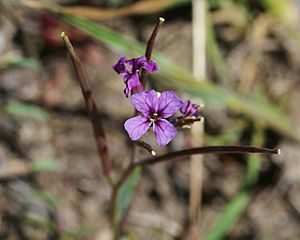Hammitt's clay-cress facts for kids
Quick facts for kids Hammitt's clay-cress |
|
|---|---|
 |
|
| Conservation status | |
| Scientific classification | |
| Kingdom: | |
| (unranked): | |
| (unranked): | |
| (unranked): | |
| Order: | |
| Family: | |
| Genus: |
Sibaropsis
S.Boyd & T.S.Ross
|
| Species: |
S. hammittii
|
| Binomial name | |
| Sibaropsis hammittii S.Boyd & T.S.Ross
|
|
Sibaropsis hammittii is a unique flowering plant, often called Hammitt's clay-cress. It's the only species in its group, called a monotypic genus. This plant is part of the Brassicaceae family, which is also known as the mustard family. Scientists first described this plant and its genus in 1997.
Contents
Discovering Hammitt's Clay-Cress
Hammitt's clay-cress is a very special plant. It is endemic to California. This means it only grows naturally in California and nowhere else in the world.
Where It Lives
This plant is found in just two main areas. One area is in the Santa Ana Mountains in Riverside County. The other area is around Viejas Mountain and nearby peaks. These places are located east of the city of San Diego.
Hammitt's clay-cress likes to grow in grassy areas. It often appears in open spaces within chaparral habitats. Chaparral is a type of shrubland common in California. You can often find it growing near purple needlegrass. It prefers moist spots with heavy clay soils.
What It Looks Like
Hammitt's clay-cress is an annual herb. This means it grows from a seed, flowers, produces new seeds, and then dies all within one year.
Stems and Leaves
The plant has a waxy stem that can be hairless or slightly hairy. This stem can grow up to about 20 centimeters (about 8 inches) tall. Its leaves are long and thin, like a line. They can be up to 4.5 centimeters long. That's about 1.7 inches. The leaves are very narrow, only about a millimeter wide.
Flowers and Fruit
The plant produces flowers that look a bit like tiny mustards. Each flower has four petals. These petals are spoon-shaped and have dark veins. They are a pretty purple-pink color. Each petal is about a centimeter (less than half an inch) long.
After the flowers bloom, they turn into a fruit. This fruit is called a silique. It's long, narrow, and flat. The silique measures about 1.5 to 2.5 centimeters long. That's roughly 0.6 to 1 inch. It's also very thin, less than a millimeter wide. Inside this tiny fruit, you can find up to 44 very small seeds.


